The NVIDIA GeForce GTX 1080 Ti Founder's Edition Review: Bigger Pascal for Better Performance
by Ryan Smith on March 9, 2017 9:00 AM ESTMeet the GeForce GTX 1080 Ti Founder’s Edition
When it comes to the design of the GeForce GTX 1080 Ti Founder’s Edition, if you’ve seen a high-end NVIDIA card in the last 4 years then you know roughly what to expect. NVIDIA has found their sweet spot in card design, and while the GTX 1080 Ti does have a few wrinkles of its own, it’s not a radical departure from the likes of the GTX 1080, GTX 980 Ti, or GTX 780 Ti. GeForce GTX 1080 Ti is a traditional NVIDIA reference card, with all the competence, performance, and functionality that entails.
At a high level, the GTX 1080 Ti Founder’s Edition is a 10.5-inch long blower-type card comprised of a cast aluminum housing and held together using a combination of rivets and screws. Designed as much for aesthetics as functionality, NVIDIA’s use of well-secured metal has done a good job of tempering noise generation, and for those who like to show off their rigs, the basic design and LED-backlit logo are unmistakable.
Cracking open the card and removing the shroud exposes the card’s fan and heatsink assembly. Once again NVIDIA is lining the entire card with an aluminum baseplate, which provides heatsinking capabilities for the VRMs and other discrete components below it, along with providing additional protection for the board. Like past NVIDIA 250W cards, the GTX 1080 FE uses NVIDIA’s vapor chamber cooler in order to maximize the heat transfer between the GPU/VRMs/DRAM and the aluminum heatsink above. As far as blower-type cards go, it’s still the card to beat.
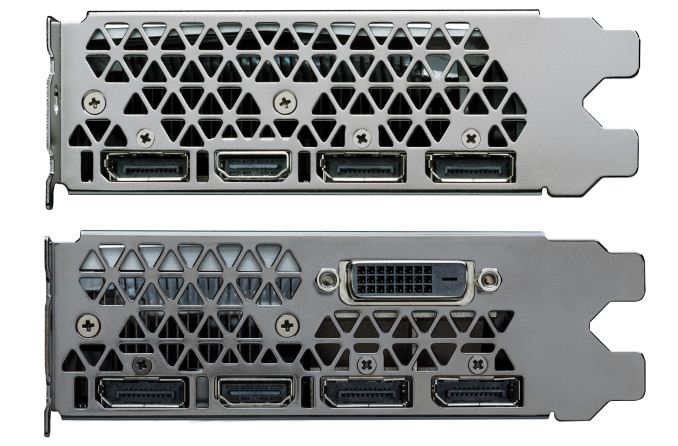
Airflow: GTX 1080 Ti vs. GTX 1080
For the GTX 1080 Ti, NVIDIA has refined this basic design just a bit in order to further increase airflow. The key change here is that NVIDIA has removed the DVI port that in past designs took up part of the second slot used for ventilation. Consequently the entire slot is now open for airflow. As we’ll see in our benchmarks the practical difference in noise is not very much, but it still means the GTX 1080 Ti is quieter than the GTX 980 Ti and GTX 780 Ti that came before it.
Otherwise in a blink-and-you’ll-miss-it kind of change, NVIDIA has also tweaked the tapering of the shroud itself to maximize the airflow. It’s difficult to pick up in pictures, but the shroud is just a bit thinner and the bottom of the shroud is just a bit higher, allowing just a bit more unobstructed airflow through the card. This subtle change is a good example of where NVIDIA is in their card design cycle: with the major performance elements of the cooler design essentially being a solved problem, NVIDIA is now toying with small changes to eke out just a bit more performance.
Popping off the cooler, we see NVIDIA’s reference PCB. This appears to be the same PCB used on the similarly configured GP102-based Titan X Pascal, and is consistent with NVIDIA’s past reuse of PCBs.
Of particular note, we can see that NVIDIA has equipped the card with a surprising number of MOSFETs, and it turns out there’s a good reason for this. For the GTX 1080 Ti, NVIDIA has opted to go with two dualFETs for each of the GPU’s 7 power phases, as opposed to the traditional 1-per-phase design used in most NVIDIA cards. While this drives up the total cost of the card a bit, the payoff is that it improves on the card’s power delivery efficiency a bit, especially at the 200W+ range the GTX 1080 Ti operates in.
This isn’t the first overall GeForce card we’ve seen with a large number of MOSFETs – NVIDIA’s board partners at times treat it as a contest in and of itself – but this is the first time we’ve seen NVIDIA use such a large number and promote it. Generally speaking additional phases and MOSFETs can improve a power delivery subsystem by spreading out the load – and in a game of inches, every bit counts – but the additional MOSFETs are subject to diminishing returns both at idle and load.
Otherwise this is a fairly typical NVIDIA PCB. The reuse of the Titan PCB means that the board should work with water blocks and other add-ons designed for the Titan, though I suspect for best overclocking results the hardcore overclockers will continue to want to look to more specialized designs from the likes of MSI, EVGA, Asus, and others.
Flipping the card over to the back, we find NVIDIA’s now-standard segmented backplate. The presence of the backplate helps to protect the card, but one or both segments can be removed to add precious millimeters of room for airflow in tightly packed SLI designs.
Moving on, towards the top of the card we find the requisite SLI and power connectors. Like NVIDIA’s 250W cards before it, the GTX 1080 Ti features a 6 pin + 8 pin setup. NVIDIA’s 250W limit means that, on-board circuitry aside, the power delivery system isn’t anywhere close to its 300W limit. Otherwise we find a pair of SLI connectors, which like the rest of the GTX 10-series cards are designed for use with NVIDIA’s latest-generation High Bandwidth (HB) bridges.
Finally, getting back to NVIDIA’s display I/O configuration, as we mentioned earlier NVIDIA has removed the DVI port from the card in favor of giving the card unobstructed airflow for better cooling. As a result, the card features only modern ports: 3x DisplayPort 1.4 and 1x HDMI 2.0b. With that said, as a consolation item of sorts for the remaining DVI users, NVIDIA is including a DisplayPort-to-SL-DVI adapter with the Founder’s Edition card. This doesn’t perfectly replace the missing DVI port – in particular, it can’t drive 2560x1440 or 2560x1600 displays – but for lower resolution displays it will do the trick. But if it’s not already clear from this change and the number of motherboards to drop DVI over the years, DVI’s days are numbered, and we’re only going to continue to see DVI ports go away at this point.


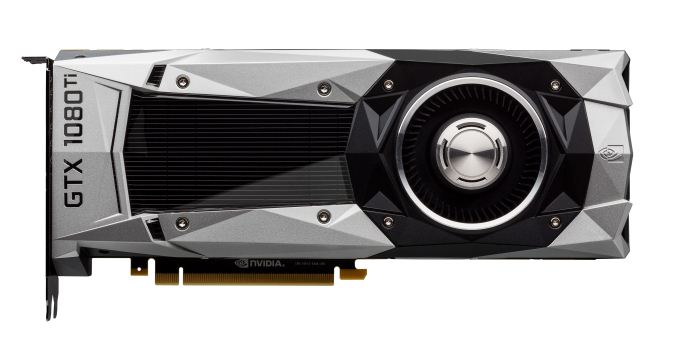
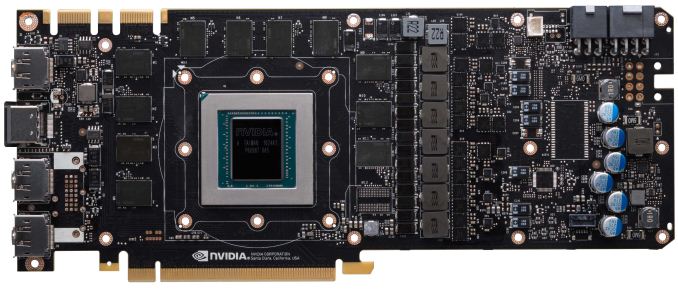
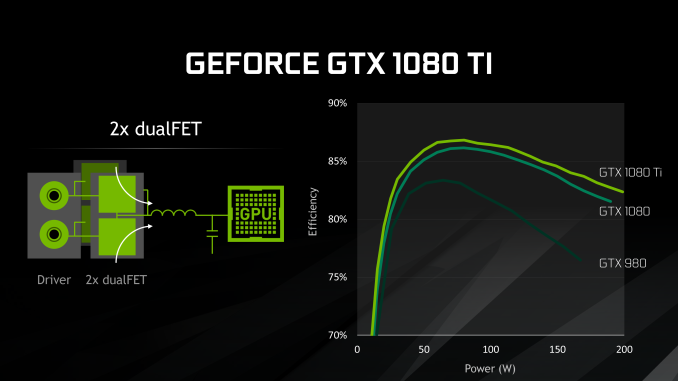
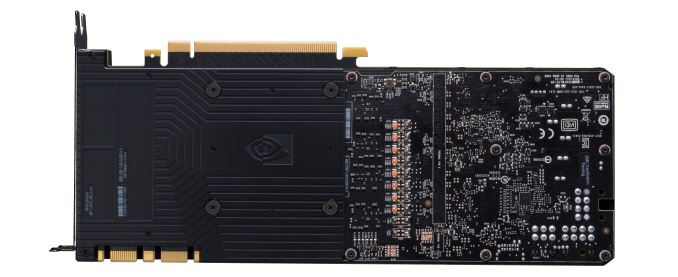
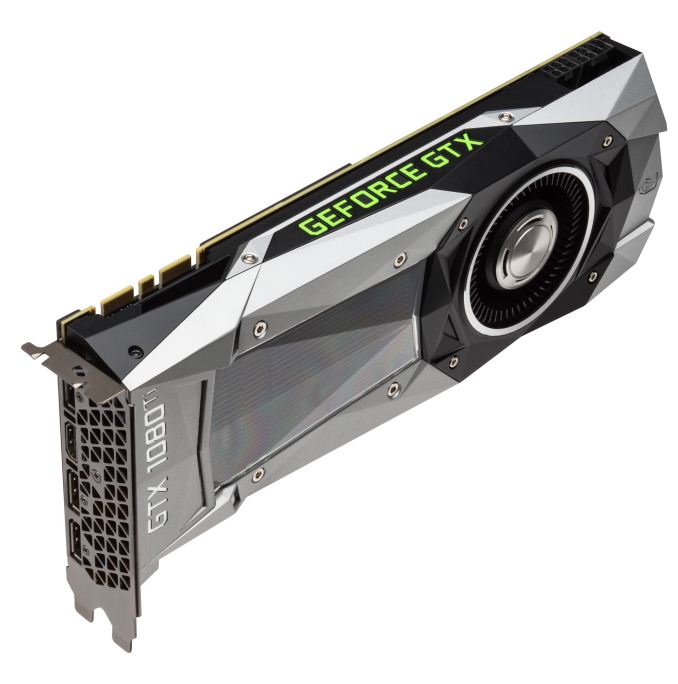








161 Comments
View All Comments
ddriver - Friday, March 10, 2017 - link
Also, granted, there are some amd optimized games, albeit few and far in between. But that doesn't excuse what nvidia does, nor does it justify it.Besides it was nvidia who started this practice, amd does simply try its best to balance things out, but they don't have nowhere nearly the resources.
amd optimized games are so rare, than out of my many contacts in the industry, I don't know a single one. So I cannot speak of the kinds of terms amd offers their assistance. I can only do that for nvidia's terms.
If amd's terms for support are just as exclusive as nvidia's, then amd is being guilty too. But even then, that doesn't make nvidia innocent. It makes amd guilty, and it makes nvidia like a 100 times guiltier.
eddman - Friday, March 10, 2017 - link
What terms? Are we back to "If we help, you cannot optimize your game for AMD"? How do you know there are such terms?Also, you said the entire helping out thing is illegal, terms or no terms. Now it's illegal only if there are certain terms?
ddriver - Friday, March 10, 2017 - link
Read the reply above. nvidia doesn't state the terms, because that would be illegal, the terms are implied, and they refuse further support if you break them... and worse... so it is a form of legal briberyand since their drivers are closed source, any hindrances they might implement to hamper your software remain a secret, but hey, there is a good reason why those drivers keep getting more and more bloated
eddman - Friday, March 10, 2017 - link
What if is nothing implied? Why are you so sure something must be implied if they're helping a dev? What if they simply want that game to work best with their hardware because it's an important game in their mind and might help sell some cards?We are heavily into guessing and assuming territory.
I'm not saying shady stuff doesn't happen at all, but to think that it happens all the time without exception would be extreme exaggeration.
ddriver - Friday, March 10, 2017 - link
There is no "nothing implied". It doesn't take a genius to figure what nvidia's motivation for helping is. Of course, if it is an important, prominent title, nvidia might help out even if the studio optimizes for amd just to save face.But then again, nvidia support can vary a lot, it can be just patching up something that would make them look bad, it can be free graphics cards and strippers as in the case of our lad above. I am sure he didn't optimize for amd. I mean that developers don't really care all that much how well their software runs, if it runs bad, just get a faster gpu. They care about how much pampering they get. So even in the case of a studio which is too big for nvidia to blackmail, there is still ample motivation to please it for the perks which they won't be getting from amd.
There is no assuming in what I say. I know this first hand. nvidia is very kind and generous to those willing to play ball, and and very thuggish with those who don't. So it doesn't come as a surprise if most of the developers chose to be on its good side. The more you please nvidia, the more you get from it, if tomorrow you apply for a job, and there is a sexy chick competing for the position, it can get the job by blowing the manager, and even if you would too, he is not into guys. You are not in the position to compete, and it is an unethical thing that wins her the job. U happy about it?
eddman - Friday, March 10, 2017 - link
You know this first hand how? You are claiming a lot and providing nothing concrete.eddman - Friday, March 10, 2017 - link
I already listed the motivation. Game runs good on their cards. People buy their cards.cocochanel - Saturday, March 11, 2017 - link
I don't understand your stubbornness. What ddriver is alluding to is questionable practices. In a free market system, fierce competition and all that, it becomes the norm. But it doesn't make it right. Free markets, you know, are like democracy. And you probably know what good old Winston had to say about that.eddman - Saturday, March 11, 2017 - link
No, he's outright calling such partnerships illegal. He claims to have "first hand" info but reveals nothing.Hardware companies working with software studios has been going on for decades. It wasn't illegal then and it isn't now.
DMCalloway - Saturday, March 11, 2017 - link
Agreed. Had Intel been fined the true value of what it gained with global dominance over the next 10+ years, things would be vastly different in Sunnyvale right now. So much so I would even speculate that Green team's only hope of viability would have come in the form of an acquisition on Blue team's part.